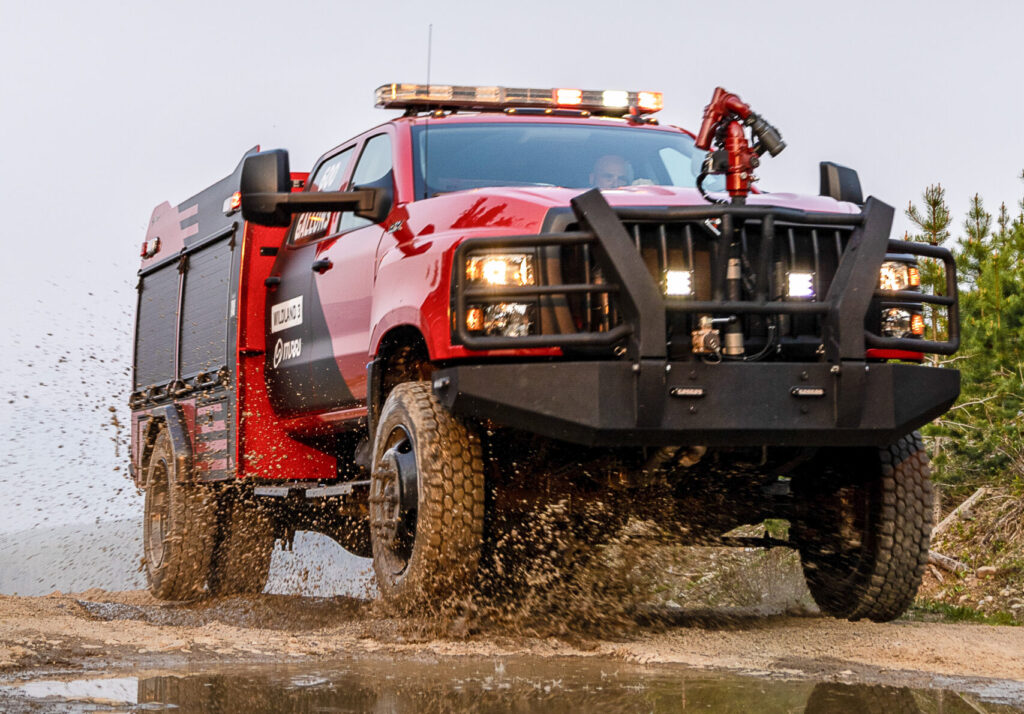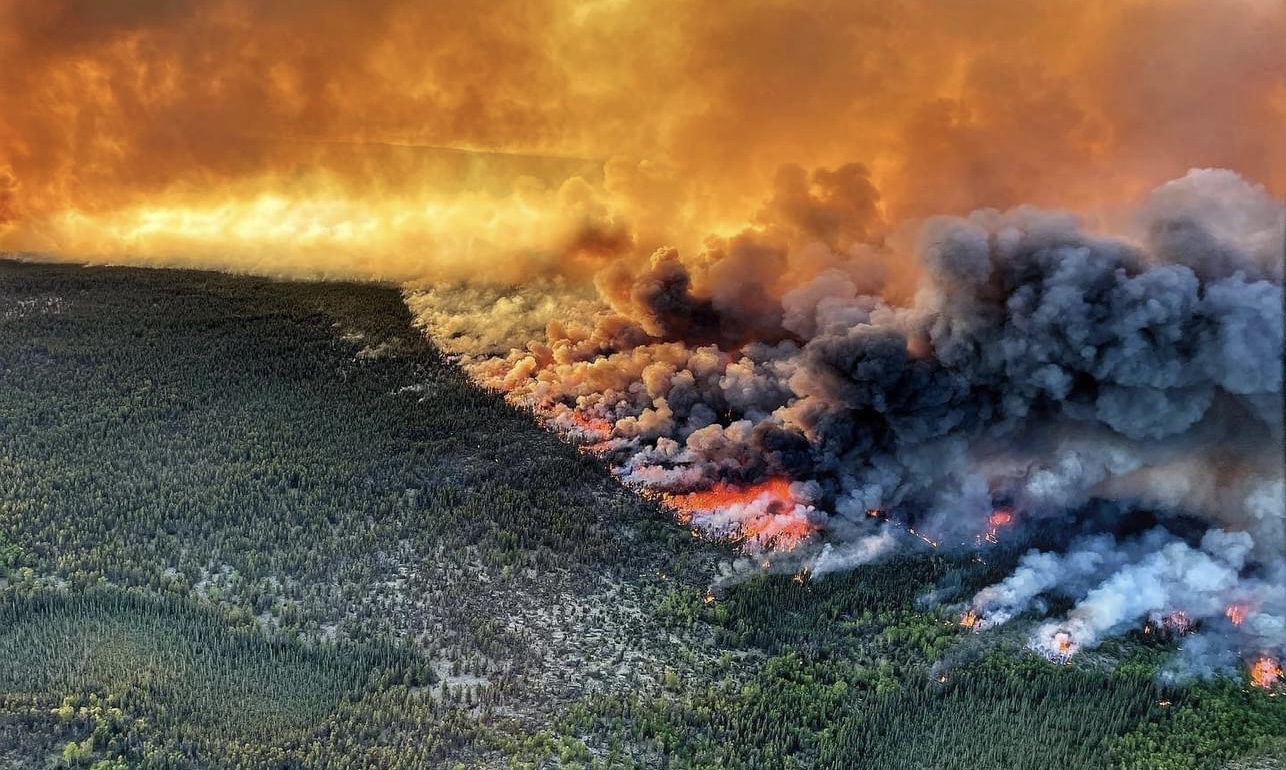
Wild fire: How technology and innovation are changing wildfire response
By Laura Aiken
Features BC Equipment fire firefighter First Responders wildfire The standards of a Type 3 in a redesigned Type 6 form – multipurpose WUI vehicles like the Wildland 3 are attracting attention for their hybrid versatility. Photo: Safetek Profire
The standards of a Type 3 in a redesigned Type 6 form – multipurpose WUI vehicles like the Wildland 3 are attracting attention for their hybrid versatility. Photo: Safetek Profire Who doesn’t love a good record-breaker? Basketball star LeBron James recently became the first NBA player to hit 40,000 points, nearly simultaneous with NCAA star Caitlin Clark breaking the points record, male or female, for college basketball. These are the best kind of broken records. Not often repeated and very inspiring. We need these.
But not all records are made to be broken. We could do without the ones wildfires and climate are absolutely smashing.
In Canada, about 2.5 million hectares burn during an average wildfire season. Around 18.5 million scorched in 2023. This totality about the size of Greece doubled the record set in 1989, reported Natural Resources Canada. Just from June 1 to 25, more land was lit up in southern Quebec than the cumulative hectares burned over the last 20 years. Canada also hit a milestone by having its warmest May to July in over 80 years, “breaking previous national temperature records for the two months by 0.8°C,” reported the federal government, which commissioned a study in the aftermath of the 2023 wildfire season that indicated “climate change made the extreme intensity of this fire season at least two times more likely than under preindustrial climate while the persistence of these conditions was at least seven times more likely.”
Quebec lost nearly 4.5 million hectares. British Columbia set records with its 2.84 million hectares lost and the province was under a state of emergency for 28 days. Ontario’s 441,000 hectares nearly tripled the 10-year average, reported the provincial government. Alberta lost over two million hectares and declared a state of emergency by May 6. Nova Scotia battled the burning of over 25,000 hectares, a record breaker on the eastern seaboard. The Northwest Territories experienced their worst season on record, one that forced almost 70 per cent of their population to evacuate over the summer, reported the Canadian government. All across Canada, wildfires reached for the record-breaking stars.
But these are numbers. Things we can quantify and discuss fairly abstractly. The emotional toll of fire fighting, evacuations, lost homes, lives disrupted and tragically fallen wildland firefighters is unquantifiable.
Resources and the role of technology
Before examining how technology is impacting the frontlines and the forecasting, let’s highlight what kind of people-power was pulled in for 2023. In Quebec, The Society for the Protection of Forests against Fire (SOPFEU) tallied 2,360 additional bodies battling the fires in June and July; exemplifying globalization in action: 343 from France, 500 from the U.S., 140 from Portugal, 140 from South Korea, 100 from Spain and a boosted domestic effort of about 1,000 troops from the Canadian Armed Forces and 140 from other agencies.
The Canadian Interagency Forest Fire Centre Inc. (CIFFC) spent 120 consecutive days at the highest National Preparedness Level, NPL5, reported the International Association of Wildland Fire, which summarized Canada’s partnerships beyond the U.S, Australia, New Zealand, South Africa, Mexico and Costa Rica agreements that were in place before 2023. In the summer of 2023, Natural Resources Canada negotiated an arrangement with Portugal and the CIFFC created interim agreements with Chile, France, Spain, South Korea and Brazil. Dated July 26, the CIFFC’s personnel mobilized graph, which shows the cumulative number of bodies categorized by initial attack firefighters, sustained action firefighters and overhead positions, “mobilized to date for the current year vs. total number of personnel mobilized annually since 1982,” shows highs in the low 3000s until you get to 2023 and the number hits 5,185.
People-power is the most vital resource on the wildfire front. Millions are being poured into technology, but innovation is also to be seen in boots on the ground.
Brian Hutchinson, who at the time of his interview with Fire Fighting in Canada was fire chief for the District of North Vancouver Fire Rescue Services but moved on March 1 to start a new position with B.C. Wildfire Service as the superintendent of provincial operations – fire services, shared an observation on task forces happening in his province.
“One of the things that I’ve noticed — one of the things that’s really innovative and it has only started to pick up a little bit — is that some of the regions in the province have started to pre-identify and pre-assemble response-based task forces, particularly in some of the areas where you have a large number of communities spread out over a wide area.”
This means that if there is an incident in the region, there is a pre-identified task force comprised of the estimated need for engines and tenders that saves calling around to the neighbouring departments to see what’s available. Instead, the request can be put in to “dispatch task force 1,” and that task force is assembled and deployed.
In Canada, about 2.5 million hectares burn during an average wildfire season. Around 18.5 million scorched in 2023.
“I think we’re going to see more of that,” said Hutchinson. “That’s certainly a model that is used throughout California in terms of how they call up and deploy resources. But what is cool about this, is that it’s the regional areas that are doing this themselves, that are recognizing the risk and the need, and they’re being able to deploy those task forces both in support of each other and in support of the provincial efforts. When there is a pre-assembled task force, it’s likely they know each other and train together, a huge operational benefit and a great resource for B.C. Wildfire when they are reaching out. Fortunately, people are being aided by some pretty cool innovations.”
One such cool innovation comes in the form of new multipurpose engines that address the wildland urban interface. Hutchinson also shared his sentiments on the unique capabilities of Safetek Profire’s Wildland 3, which North Vancouver acquired. This engine deviates from the typical Type 3 engine that is more similar in size to a Type 1. During his tenure as the fire chief in North Vancouver, Hutchinson was looking for a Type 3 capacity—one that holds a large volume of water for organic material or things like a car or home that catches fire when the wildfire creeps. North Vancouver’s terroir involves a lot of steep terrain and narrow, windy roads that limit maneuverability. There are areas in the jurisdiction with limited or no fire hydrant access. The Wildland 3 caught his eye as a perfect hybrid of capacities by meeting all the standards of a traditional Type 3 engine while offering the maneuverability and lightness that a traditional Type 6 brings. “It was innovative for us to blend all those pieces together.”
The hybrid nature of the Wildland 3 means it can get to those structures located in difficult-to-reach terrain and be deployed as a first-in unit for a structure fire, as it has both the SCBA and a large tank of water to get fire fighting operations underway. A Type 1 engine can be brought in as backup. It’s a very multipurpose vehicle, generally, in the urban environment, he noted, and because it doesn’t have air brakes it doesn’t require air brake certification, expanding the pool of potential drivers.
BME Fire Trucks, represented in Canada by Commercial Emergency Equipment, have a Wildland Urban Interface engine in the works that promises to offer a similar versatility as the Wildland 3 in terms of being both a structural and wildland responder. BME describes the Bighorn as having “increased maneuverability, 1250-1500gpm midship pump, wildland pump and roll capability, this engine provides a lot of resources for a lower cost. The WUI also offers a great return on investment (ROI) because it can be deployed on contract fires, meets ISO insurance requirements, and is a multi-use engine that can operate in many environments.”
Fire engine innovations are rising to meet demands for versatility, and pump technology is evolving to address the need to tap and move large amounts of water. Hutchinson noticed the focus on moving mass water picking up in 2021 in B.C. with the recognition of how water supply could be negatively impacted via wildland or post-disaster settings. The North Vancouver environment is tidal, he explained, so it is not conducive to traditional drafting techniques that involve lowering drafting hoses in to pump water out (tides get high, embankments get steep). The North Vancouver department invested in two HydroSub units from Hytrans Systems. These units are powerful mobile pump systems to harness the supply of water in rivers, lakes and oceans. The hydraulically driven submersible pump is designed to provide quick access to open water, even if it is over a kilometre away, and without losing steam as it pumps over long distances.
Gord Parker, structure protection specialist with B.C. Wildfire Service, observed that these systems are becoming a key component of response in light of the recognition that the domestic water system is simply not robust enough. And you really don’t want to run out of water in a WUI environment.

Photo: Tyler Pelke
“We want to keep things foolproof,” said Parker.
The provincial system is two Trident pump systems, said Parker, each moving about 750 gallons a minute with the power to go around a mile from Point A to Point B.
“Large volume is also about ground storage tanks,” said Parker. “We are constantly looking at ways of moving and storing water.” Tanks systems are becoming more prominent. There are also investigations occurring to verify if less water can be used and when a sprinkler system can be as effective.
Hutchinson said he has seen structure protection units grow in prominence for urban departments, with North Vancouver and neighbouring departments becoming equipped with them. These are trailers roughly 20 feet long and equipped with enough sprinklers, pumps and bladders to do sprinkler protection for about 35 homes as a defence mechanism when you are predicting the fire is going to impact the community. Set up the sprinklers about a half hour or hour before the fire is expected to begin its impact. This creates a humidity bubble, and when the fire in the trees or moving forward quickly pushes against this humidity bubble, the humidity bubble will push the fire to the ground where it’s then easier to manage, as well as casting fewer embers, Hutchinson explained.
Of course, the foreseeable frontier in wildfire operations also includes intelligence tech. When queried as to what else he sees on the horizon, Parker noted drones for tracking and unmanned aerial autonomous vehicles that can drop retardants. Early detection sensors, like those made by the German company Dryad Networks, were trialled by Cal Fire last year. Dryad developed a solar-powered gas sensor designed to “smell” a fire before it erupts. These ultra-early detection systems use long-range wide area networks to communicate with a satellite and the 4G LTE connection built into it. It’s all impressive gadgetry, but no one innovation or technique saves the day. The continued development of the FireSmart program in Canada is critical to wildfire preparedness. Prescriptive and Indigenous cultural burning are both practices Parker thought we’d see more of.
No one piece of technology or innovation will work magic on our new reality of hotter, faster, more intense and frequent wildfires, which by all accounts seem very likely to continue. The magic is in the fire service that works together to harness them.
Print this page
Advertisement
- Small forest fire put out in Oka provincial park as Quebec fire season starts early
- Winnipeg crews battle pair of fires Sunday